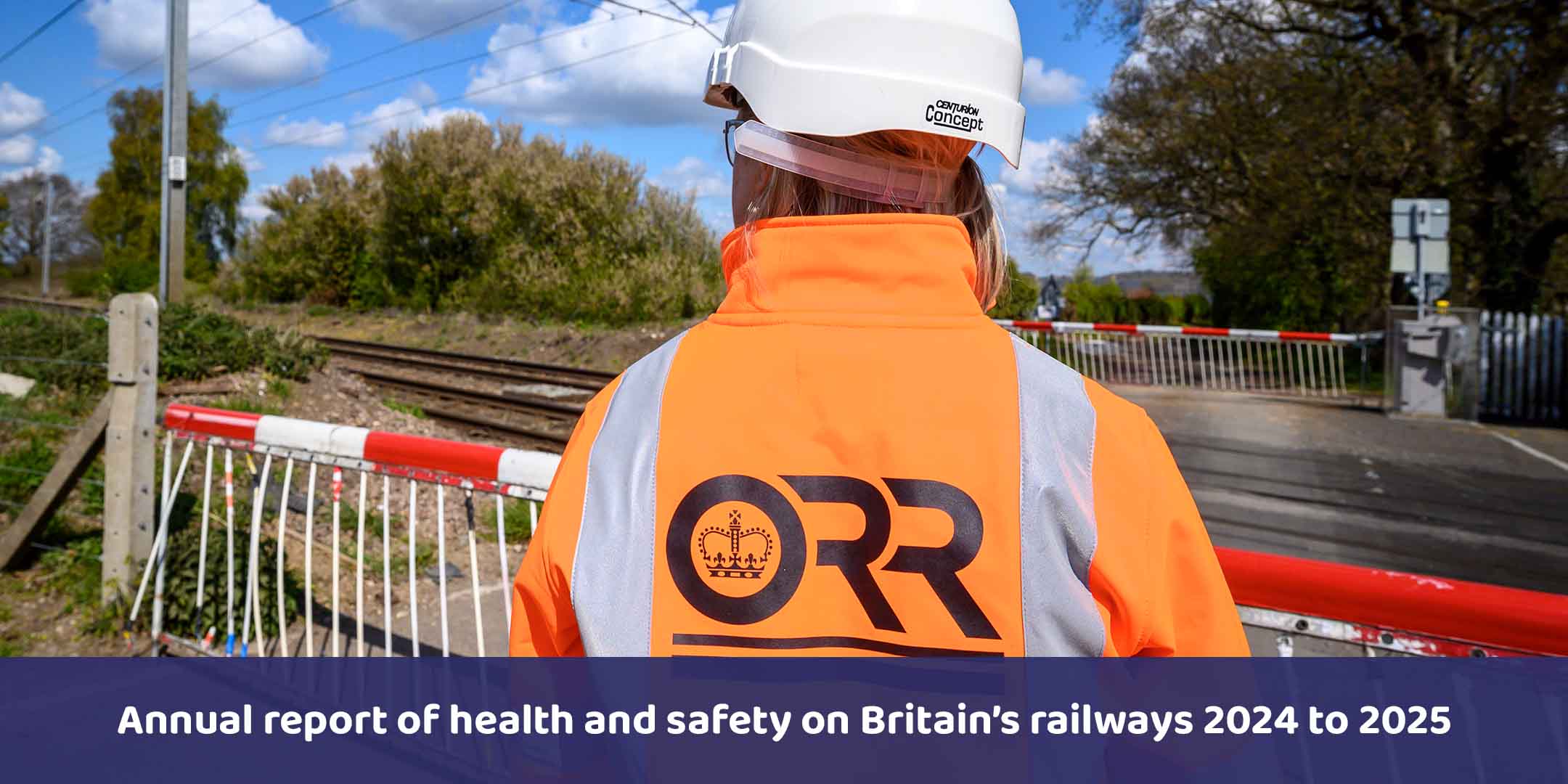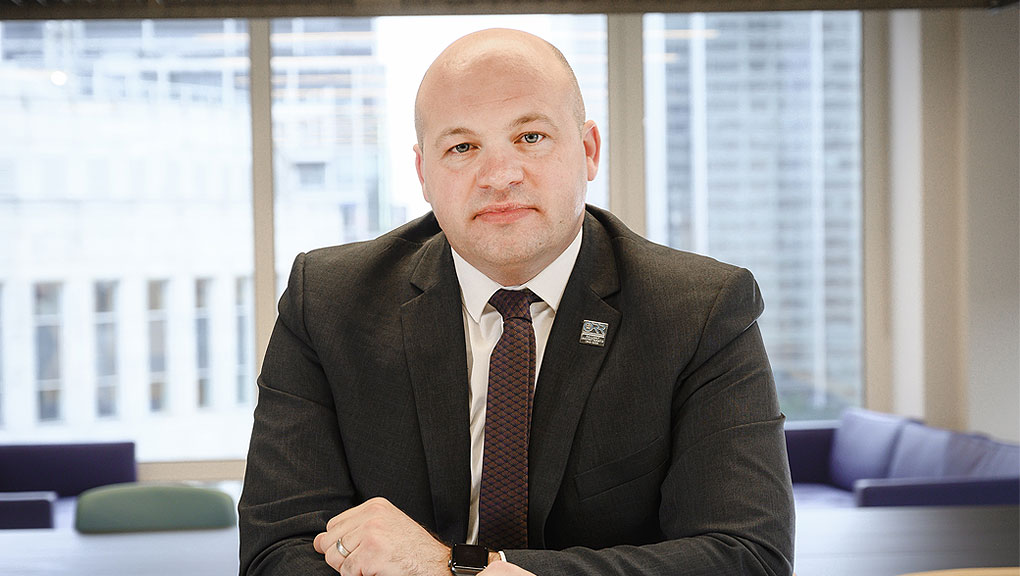Covering the period from 1 April 2024 to 31 March 2025

Chief Inspector's Review
by Richard Hines
HM Chief Inspector of Railways and Director of Railway Safety

Safety is the railway’s most critical obligation. It forms the foundation on which trust and confidence in the system is built.
Achieving good health and safety outcomes in a complex, inherently high-risk environment does not happen by chance. It's the product of extensive investment, strong leadership, innovation, collaboration across interfaces, and ensuring previous mistakes are never repeated. It also requires thousands of individuals across the industry to help keep the network healthy and every day through their expertise, commitment, and professionalism.
We must however remain vigilant. The fatal train collision at Talerddig last year, which claimed one life and injured many others, was a sobering reminder of what can happen when risk controls fail. Only two weeks earlier, I had stood in the Ladbroke Grove memorial garden, reflecting on the profound loss and lasting impact of another tragedy 25 years ago. The proximity of these moments was deeply moving.
This is not a ‘normal’ year for our mainline railway, although our non-mainline systems remain largely unaffected. It is entering a period of profound change, shaped by the most significant reform agenda in a generation. The creation of Great British Railways (GBR) and the restructuring of the industry are intended to simplify, integrate, and modernise how our railway works. But as we start this period of transformation, also in the context of a constrained financial environment, the health and safety of passengers, workers, and the public must remain the priority for the duration.
Reform provides an opportunity to build upon current strengths. Done well, a more integrated railway – underpinned by unified leadership – can better identify and manage risk, close long-standing gaps at interfaces, and enable faster, more joined up responses to address priority issues. There are also huge opportunities to evolve our safety culture, and create a more inclusive, diverse workforce that attracts and retains the brightest talent.
At the same time, reform introduces areas of uncertainty. If attention is diverted from the day-to-day safety of the railway, or if roles and responsibilities are not clearly defined, there is a risk that safety performance could be compromised. Proactive risk management, clear accountability, and visible safety leadership at every level will be essential to ensure that health and safety remains not just a priority, but a guiding principle – through every decision, in every part of the system.
The following sections of this report describe our assessment of the railway industry’s health and safety performance for the year. A series of practical case studies are also included. My key reflections from the last work year are briefly summarised below.
Network Rail
Network Rail maintained good health and safety performance during the year. Substantial progress was made in addressing overdue assessments for structures and dealing with weather-related risk, although this has been delivered in the context of focussed regulatory attention.
Overall train accident risk was broadly consistent with recent years. However, serious incidents remain a concern, including 29 high potential risk events – mostly at level crossings. A freight train derailment in Audenshaw in September 2024 caused significant infrastructure damage, although there were fortunately no injuries. Our investigation identified shortcomings in track maintenance practices which has been the subject of targeted enforcement action (see the Network Rail section of this report for further details).
Network Rail’s Occupational Health team continues to lead a positive shift in the organisation’s approach to health risks, although further work is required on topics such as the management of exposure to welding fume.
Mainline operators
The number of Signals Passed at Danger (SPADs) continued to increase, although the number of high-risk events remained relatively stable. Improving the consistency and quality of SPAD cause recording, including adhesion related events, is important to support more effective industry-wide learning and mitigation. An effective approach to address concerning overspeeding events also requires coordination between operators and infrastructure managers.
Our updated guidance on Managing Rail Staff Fatigue received a positive industry response and we continued work to understand and test industry’s capability to manage digital safety risks.
Non-mainline railways
We continued our focus on London Underground’s maintenance practices for ageing building assets, particularly related to water ingress, identifying areas where risk management could be strengthened. We also concentrated on their change management approach for the highly complex four-lines modernisation programme.
We maintained strong strategic collaboration with the Light Rail Safety and Standards Board (LRSSB) and our proactive regulatory efforts across tramway networks looked at two key areas – Medical Fitness of Safety-Critical Staff and Non-Motorised User Crossings.
Policy, strategy, and statutory activities
We delivered a range of statutory work through health and safety permissions and approvals, including those associated with the transition of Train Operating Companies into public ownership. We served four Improvement Notices during the year and concluded three criminal prosecutions, including two relating to the deaths of trackworkers at Margam and Surbiton.
We collaborated with our economic colleagues and industry to review how businesses assess the costs and benefits of health and safety interventions in rail. We identified important learning points to support best practice and improve consistency.
We continued work with the Department for Transport to explore options for streamlining the current statutory train driving licensing regime. A key early outcome of this review (subject to a change in the law) was the agreed reduction of the minimum licensed train driver age from 20 to 18 years.
Finally, we invested in our own capability by establishing three cohorts of trainee Inspectors and Inspector Assistants, alongside strengthening the continuous professional development of our qualified staff to ensure their skills and knowledge remain aligned with the evolving railway environment.
Themes for the year ahead
The publication of our Annual Health and Safety Report provides an opportunity to set out what I consider to be the main themes and areas of challenge for the year ahead. I have three:
1. Keeping today’s railway healthy and safe – building the foundation for tomorrow
The responsibility to operate a safe railway every day remains constant. A safe and healthy railway today is the foundation for a better railway tomorrow. Fulfilling this responsibility demands focus, coordination, and sustained industry commitment.
Key priorities include:
- Maintaining health and safety performance: Ensuring day-to-day risks are actively managed in the context of a changing risk profile and environment.
- Clear accountability: Reinforcing responsibilities and expectations at every level of the system, from executive leadership to front-line teams and our supply chain.
- Consistent delivery and continual improvement: Driving alignment across operators, suppliers, and other key stakeholders to deliver good outcomes across the system. Using current data, incidents, and operational learning to make informed improvements without delay.
For the year ahead, we will maintain a relentless focus, using a diverse range of regulatory interventions, to ensure that the industry remains vigilant and delivers a safe and healthy railway every day.
2. Embedding health and safety at the heart of reform and change
Safety must remain the guiding principle throughout this period of change. Change brings opportunity, but also complexity and risk. By embedding health and safety thinking from everyone with expertise into every stage of reform – from strategic design to implementation – we must ensure that transformation and change strengthens, rather than compromises, the safety of our workforce, customers, and operations.
Key priority areas include:
- Safety-led transformation: Ensuring change and reform is designed and delivered with desired health and safety outcomes in mind.
- Leadership accountability: Keeping safety at the centre of decision-making during organisational and system change.
- Resilience through transition: Managing change without compromising the integrity of safety-critical systems and supporting arrangements.
We will continue to engage in rail reform discussions, providing advice on good health and safety principles and scrutinising proposals as they emerge. We will leverage our unique position to convene conversations where required.
3. Enhanced collaboration across interfaces: A necessary safety leadership capability
In inherently high-risk, complex systems, collaboration is not optional – it is a core leadership capability. Leaders who collaborate effectively are better equipped to manage complexity, align diverse perspectives, and expedite the adoption of technology. Collaborative leadership within and between organisations enables better decision-making, builds a stronger safety culture, and delivers more resilient operations – especially in times of change.
Key priorities include:
- Leadership capability: Building arrangements and ways of working that develop collaboration and shared understanding of risks and opportunities.
- Greater alignment: Examples of leaders and organisations sharing information, driving joint safety planning, and where applicable, integrated risk management approaches across interfaces.
- Partnering and cultural modelling: How leaders partner with everyone with relevant expertise (including system users, the railway workforce, unions, supply chain) to deliver successful safety outcomes. Senior leaders must demonstrate humility, openness, and inclusion to foster trust and collective accountability.
We have a strong track record of collaboration and convening industry to work together to fix important problems. These approaches will continue to feature prominently in how we work in the future, whilst also being mindful of the importance of upholding our role as an independent regulator.
Looking forward
To effectively deliver our regulatory functions, we rely on every part of the system to play its part. Thank you to the many individuals and organisations across the industry for all you have contributed over the last 12 months.
I am also grateful to those whom I have had the pleasure of visiting and meeting during my first year as Chief Inspector. I value your insight, and I am committed to continuing to evolve our approach and deliver regulatory excellence in all that we do to help deliver a healthier and safer railway.
I look forward to working with you during the year ahead.

